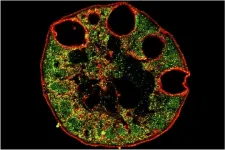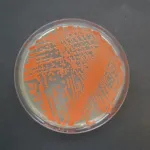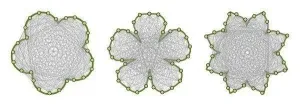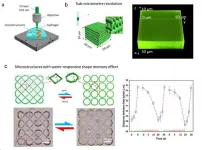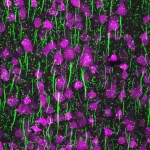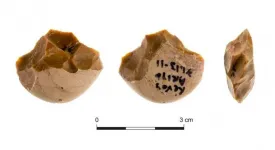(Press-News.org) No evidence so far indicates that food or drinks can transmit the virus that causes COVID-19, but new research at Washington University School of Medicine in St. Louis suggests that people with problems in the upper gastrointestinal (GI) tract may be vulnerable to infection after swallowing the virus.
Studying tissue from patients with a common disorder called Barrett's esophagus, the researchers found that although cells in a healthy esophagus cannot bind to the SARS-CoV-2 virus, esophageal cells from patients with Barrett's have receptors for the virus, and those cells can bind to and become infected by the virus that causes COVID-19.
The study is published online Jan. 20 in the journal Gastroenterology.
"There is no evidence yet that people with Barrett's esophagus have higher rates of COVID-19 or are at any greater risk, but part of the reason is because that hasn't been studied," said senior investigator Jason C. Mills, MD, PhD. "Now that we've connected these dots, it may be worthwhile to look and see whether people with Barrett's have higher rates of infection."
Part of the reason it's been considered safe to eat and drink most foods during the pandemic is that they are unlikely to carry viral particles. And even if some viral particles are attached to food, stomach acid neutralizes the SARS-CoV-2 virus.
But when stomach acid backs up, people develop a disorder called gastric reflux that can cause long-term damage to the esophagus. In those with reflux disease, which affects about one in five people in the U.S., acid from the stomach backs up into the esophagus, causing heartburn and damaging the lining of the esophagus. Over time, in some people with reflux, cells in the esophagus change and begin to resemble intestinal cells. Intestinal cells have receptors that can bind to the novel coronavirus, so Mills and his colleagues reasoned that in Barrett's patients, the cells that line the esophagus also would develop receptors that can bind to the virus and become infected.
In addition, standard medical management for patients with Barrett's esophagus is to suppress gastric acid secretions with drugs such as proton pump inhibitors. By reducing stomach acidity, those drugs may inadvertently make it possible for the virus to pass through the stomach and into the intestine, where even the normal, healthy cells carry receptors for SARS-CoV-2.
Many patients with COVID-19 -- most of whom contract it by breathing in the viral particles -- develop GI symptoms such as abdominal pain and diarrhea. The virus also has been found in the stool of COVID-19 patients. But this new study demonstrates that under the right circumstances, the virus also may have an impact in the upper part of the GI tract. As a result, Mills -- a professor of medicine, of developmental biology, and of pathology and immunology -- and his team believe esophageal cells in Barrett's patients are potential gateways for infection.
"You can imagine that if someone already has low levels of the virus in their respiratory tract, that individual could swallow some respiratory secretions, and the virus could infect cells in the esophagus to make them sicker that way," said Ramon U. Jin, MD, PhD, the paper's co-first author and a clinical fellow in the Division of Medical Oncology who studies Barrett's esophagus because it is a major risk factor for cancer of the esophagus. The other co-first author, Jeffrey W. Brown, MD, PhD, is an instructor in medicine in the Division of Gastroenterology.
In this study, the researchers analyzed tissue from 30 patients with Barrett's esophagus and found that cells in the tissue samples all had receptors for the SARS-CoV-2 virus, which normal esophagus cells lack. They built and cultured mini organs from those and other esophagus tissue samples. Some of the sample organs were built with cells that came from healthy people while others came from patients with Barrett's esophagus. The scientists built the mini esophaguses, called organoids, in a dish to learn how those model organs interacted with the SARS-CoV-2 virus.
The virus was able to bind to and infect mini organs built from tissue from people with Barrett's esophagus. Moreover, the more the cells in a specific patient's mini esophagus culture resembled intestine, the more the virus bound to and infected that culture.
"The worry would be that, particularly for Barrett's patients, there even may be a susceptibility to infection from foods containing viral particles," Mills said. "This study provides data to indicate that we need to take a closer look to investigate whether a substantial portion of the population may be susceptible to infection through what they swallow."
INFORMATION:
Jin RU, Brown JW, Li QK, Bayguinov PO, Wang JS, Mills JC Tropism of SARS-CoV-2 for Barrett's esophagus may increase susceptibility to developing COVID-19. Gastroenterology, Jan. 20, 2021.
This work was supported by the National Cancer Institute, the National Institute of Diabetes Digestive and Kidney Diseases and the National Heart, Lung, and Blood Institute of the National Institutes of Health (NIH). Grant number P30 CA091842, P30 DK052574, P30 CA006973, T32 HL007088, U54 CA163060, R21 DK111369, R01 DK105129, R01 DK110406. Additional support from an American Gastroenterological Association Foundation AGA-Takeda COVID-19 Rapid Response Research, the Department of Defense, the Children's Discovery Institute of Washington University and St. Louis Children's Hospital, the Foundation for Barnes-Jewish Hospital and the Alvin J. Siteman Cancer Center at Barnes-Jewish Hospital and Washington University School of Medicine in St. Louis.
Washington University School of Medicine's 1,500 faculty physicians also are the medical staff of Barnes-Jewish and St. Louis Children's hospitals. The School of Medicine is a leader in medical research, teaching and patient care, ranking among the top 10 medical schools in the nation by U.S. News & World Report. Through its affiliations with Barnes-Jewish and St. Louis Children's hospitals, the School of Medicine is linked to BJC HealthCare.
20 January 2021/Kiel. Numerous natural products are awaiting discovery in all kinds of natural habitats. Especially microorganisms such as bacteria or fungi are able to produce diverse natural products with high biomedical application potential in particular as antibiotics and anticancer agents. This includes the so-called red yeast of the species Rhodotorula mucilaginosa, isolated from a deep-sea sediment sample from the Mid-Atlantic Ridge and analyzed for its genome and chemical constituents by researchers from GEOMAR Centre for Marine Biotechnology (GEOMAR-Biotech) ...
In a paper published in NANO, researchers from Hubei, China discuss the top-down and bottom-up strategies for the synthesis of Graphene quantum dots (GQDs). The respective advantages and disadvantages of these methods are summarized. With regard to some important or novel ones, the mechanisms are proposed for reference. In addition, the application of GQDs in biosensors is highlighted in detail.
At present, various top-down methods, such as oxidative cutting, hydrothermal or solvothermal reactions, electrochemical oxidation, ultrasonic-assisted or microwave-assisted process, chemical vapor deposition (CVD) have been reported to produce GQDs. Meanwhile, the bottom-up methods have been ...
Changes in climate that occur over short periods of time influence biodiversity. For a realistic assessment of these effects, it is necessary to also consider previous temperature trends going far back into Earth's history. Researchers from the University of Bayreuth and the University of Erlangen-Nuremberg show this in a paper for Nature Ecology and Evolution. According to the paper, future climate-related species extinction could be less severe than predictions based only on the current trend of global warming. However, the researchers do not give the all-clear. At present, the effects of climate change are being exacerbated ...
In nature, many things have evolved that differ in size, color and, above all, in shape. While the color or size of an object can be easily described, the description of a shape is more complicated. In a study now published in Nature Communications, Jacqueline Nowak of the Max Planck Institute of Molecular Plant Physiology and her colleagues have outlined a new and improved way to describe shapes based on a network representation that can also be used to reassemble and compare shapes.
Jacqueline Nowak designed a novel approach that relies on a network-based shape representation, named visibility graph, along with a tool for analyzing shapes, ...
The study explains the benefits of both the wing shape and the flexibility of their wings.
The Lund researchers studied the wingbeats of freely flying butterflies during take-off in a wind tunnel. During the upward stroke, the wings cup, creating an air-filled pocket between them. When the wings then collide, the air is forced out, resulting in a backward jet that propels the butterflies forward. The downward wingbeat has another function: the butterflies stay in the air and do not fall to the ground.
The wings colliding was described by researchers almost 50 years ago, but it is only in this study that the theory has been tested on real butterflies in free ...
Three-dimensional (3D) direct laser writing (DLW) based on two-photon polymerisation (TPP) is an advanced technology for fabricating precise 3D hydrogel micro- and nanostructures for applications in biomedical engineering. Particularly, the use of visible lasers for the 3D DLW of hydrogels is advantageous because it enables high fabrication resolution and promotes wound healing. Polyethylene glycol diacrylate (PEGda) has been widely used in TPP fabrication owing to its high biocompatibility. However, the high laser power required in the 3D DLW of PEGda microstructures using a visible laser in a high-water-content environment limits its applications to only those below the biological laser power safety level.
In a new paper ...
Rather like David versus Goliath, it appears that Saturn's tilt may in fact be caused by its moons. This is the conclusion of recent work carried out by scientists from the CNRS, Sorbonne University and the University of Pisa, which shows that the current tilt of Saturn's rotation axis is caused by the migration of its satellites, and especially by that of its largest moon, Titan.
Recent observations have shown that Titan and the other moons are gradually moving away from Saturn much faster than astronomers had previously estimated. By incorporating this increased migration rate into their calculations, the researchers concluded that ...
To process information in our brains, nerve cells produce brief electrical impulses, called action potentials, triggered from one highly specialized region. Research from the Netherlands Institute for Neuroscience, together with researchers from Heidelberg University and the University of Göttingen in Germany, now show that the electrical trigger sites surprisingly change with experience; they are either becoming smaller with increasing number of experiences and, vice versa, they grow larger when less input arrives in the brain. The results were published in Nature Communications.
Exploring the environment
Rodents learn about their environment by moving their highly sensitive whiskers, with which they touch ...
Researchers from the Sonia and Marco Nadler Institute of Archaeology at Tel Aviv University unraveled the function of flint tools known as 'chopping tools', found at the prehistoric site of Revadim, east of Ashdod. Applying advanced research methods, they examined use-wear traces on 53 chopping tools, as well as organic residues found on some of the tools. They also made and used replicas of the tools, with methods of experimental archaeology. The researchers concluded that tools of this type, found at numerous sites in Africa, Europe and Asia, were used by prehistoric humans at Revadim to neatly break open bones of medium-size animals such as fallow deer, gazelles and ...
UV-radiation can affect hormone levels of postmenopausal women negatively and this may contribute to several health issues.
The concentration of oestrogens in the blood affects a woman's health in many ways. For example, oestrogens contribute to a strong bone structure and help wounds heal more quickly:
"When a woman reaches menopause, we see the levels of oestrogens decline and an increase of other hormones, called gonadotropins", says Kai Triebner at the University of Bergen.
For several years, he has studied the hormonal balance of women in relation to menopause: What effects changing hormone levels ...
